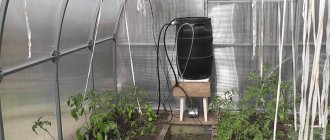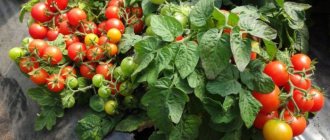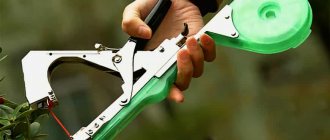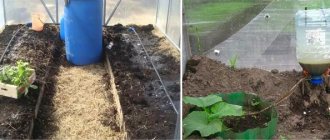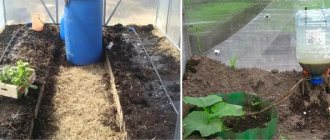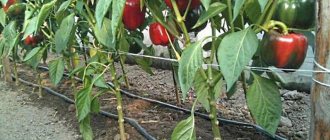SHARE ON SOCIAL NETWORKS
FacebookTwitterOkGoogle+PinterestVk
For the proper development of plants in the greenhouse and guaranteed receipt of a good harvest, the irrigation system should be properly organized. Drip irrigation from a barrel for a greenhouse is the most acceptable option. The device can be purchased as a kit or made independently from ready-made components. Recommendations for choosing the components of the system and the sequence of its installation are described in detail in this article.
Drip irrigation is the most effective and economical for irrigation of greenhouses
Drip irrigation from a barrel for a greenhouse: how the system works
Drip irrigation was first used in 1950 in Israel. This area was characterized by water shortages, so scientists tried to find a way to irrigate plants with minimal consumption of water resources. As practice has shown, this irrigation option allowed saving not only water, but also labor resources, and also contributed to an increase in yield by 30-40%.
The operating principle of drip irrigation is based on the supply of water in small quantities directly to the root system of the plant
For greenhouses, it is most advisable to organize a drip irrigation system from a barrel. It consists of a storage tank, a main pipeline and outlet hoses with droppers. All elements are connected using shaped components: angles, tees, connections to the tap, repair fittings.
Helpful advice! The fewer fittings are involved in the system, the higher the water pressure.
The principle of operation of such irrigation is as follows. A line is drawn from the storage tank through a filter, to which outlet pipelines are connected, located along the entire length of the beds. They have holes with a diameter of 3-8 mm for droppers evenly along the entire product, through which the liquid seeps to the roots of the plants. To create pressure, the container must be located at a certain height of 0.5-3 m. This ensures gravity watering. If the pressure is not enough, then you should install a submersible pump for drip irrigation from a barrel.
To create water pressure in the main pipe of the system, it is necessary to install containers at a low height or use a pump
The system can be automated by installing a controller that will allow watering at a certain time with the required intensity. In addition, installing several timers in some parts of the network will allow you to create a specific watering regime individually for each group of plants.
Operating principle
We will describe in detail the device of drip irrigation in a home greenhouse. With this method, water is supplied using dispensers-droppers (nozzles). Its simplest version is a hose with 3-8 mm holes made in it and the main spout plugged with a plug.
To ensure pressure, a tank filled with water with a hose lowered into it is raised to a certain height. Depending on the required pressure, it can be from 1 to 10 m. More complex systems are automated, but we will talk about this below.
Drip irrigation scheme
Drip watering should only be done under the roots of plants. When water is supplied between the rows, there will not be enough moisture for the roots, and the crops will develop worse. At the same time, the soil around it will become compacted and loosening will be required. Plus, wet soil under the rays of the sun will overheat, which will adversely affect growth.
The source of water does not have to be a tap or a barrel. They can serve as a well, a well or a reservoir. To do this, you will need to connect a pump to the system.
But in any case, the mandatory installation of a filter is required - otherwise the pipeline will quickly become clogged. When drawing water from an open source (reservoir), it is first necessary to install a coarse filter, and only then a fine filter. In other cases, a single fine filter is sufficient.
But still, to water a greenhouse or vegetable garden, it is better to heat the water in the sun before watering. For this purpose, containers (barrels) of suitable size are used. When it is raised to a certain height, water will flow into the system by gravity.
The pump will only be needed to draw water if there is no water supply or its pressure is low.
Advantages of a drip irrigation system in a greenhouse
Conventional surface watering allows you to quickly saturate the soil with moisture to a depth of no more than 10 cm. However, after some time, the surface layer of the earth dries out and becomes knocked down, which prevents the free flow of oxygen to the roots of plants. Drip irrigation gradually saturates the root system with moisture. This encourages root growth and maximum nutrient extraction from the soil.
The rest of the soil near the plant remains dry, which eliminates the possibility of waterlogging and waterlogging of the soil. This has a beneficial effect on the health of green spaces, since in a waterlogged environment diseases such as gray and white rot, powdery mildew, bacterial spot and blackleg develop, which can destroy plants.
Drip irrigation acts precisely on the planting site, leaving the rest of the bed dry, so the risk of waterlogging is eliminated
Do-it-yourself drip watering of the greenhouse reduces the likelihood of plant burns that occur when moisture gets on the leaves. In such cases, small drops act as lenses through which the sun's rays can leave burns on the surface of the leaves. Since irrigation is directed exclusively to the root zone, the weeds will not receive the proper amount of moisture, which will impair their development. In addition, this system prevents soil erosion.
As numerous reviews prove, drip irrigation from a barrel for a greenhouse allows you to provide a sufficient supply of water, which makes it possible to water in the absence of electricity for several days. Such a system can be used to apply fertilizer directly to the roots of plants, and this will save on fertilizer.
In the barrel, the water is heated to ambient temperature. Therefore, plants will not experience stress when watered with cold water, which significantly slows down the growth of green spaces.
Watering from a barrel ensures constant hydration; you just need to make sure the tank is filled
Reviews
Summer residents note a reduction in the number of days of full watering when using drip irrigation from a barrel.
For 60 cucumber roots, a 100 liter tank is not enough for a week . You have to come in the middle of the week and top up the barrel. It is better to stock up with a capacity of 200 liters.
This volume of water is enough to water a tomato. In general, the gardeners are happy; they no longer need to come and water the greenhouse every day after work. With this type of irrigation, watering is carried out with water heated in the sun.
Gardeners also note low water consumption. I like everything, but they advise raising the tank no less than 2 m, weeds do not grow, the system is quickly washed and repaired.
Disadvantages of a drip irrigation system for greenhouses
When organizing a drip irrigation system in a greenhouse, you will need to pay due attention to constant monitoring. An excess of moisture resulting from incorrect calculation will contribute to a significant waste of water and will be detrimental to plants. The barrel should be checked regularly and filled on time.
The disadvantages of the system also include the need to periodically clean the holes, since, having a small diameter, they quickly become clogged. This is especially true for underground pipe laying. To clean the holes, flush and blow out the system using a compressor. It is not recommended to increase the diameter of the holes, since water will pour out at the beginning of the system and will not reach the last nozzle holes.
Helpful advice! To protect the drip irrigation system from contamination, install a filter at the outlet of the barrel or use a piece of foam rubber instead.
To achieve the best effect, it is necessary to carefully calculate the amount of water supplied to the system and the dosage for each plant.
Recommendations for choosing a barrel for drip irrigation
Since a barrel was chosen as a source of water supply for the greenhouse irrigation system, it must be of high quality and designed for a certain volume of water. The size of the tank directly depends on the total area of the greenhouse. Mostly for small greenhouses, a container of 200 liters is sufficient to provide the necessary supply of liquid.
The tank can be made of plastic, stainless steel or carbon steel. Plastic barrels are available in various configurations and sizes. Such products are light in weight, have sufficient strength, are not prone to corrosion, and are easy to install and operate. Stainless steel containers are durable (more than 30 years) and have increased resistance to corrosion. The material is not afraid of mechanical and aggressive influences. The main disadvantage of stainless steel tanks is the high cost of the products.
Plastic water barrels are the most profitable and convenient to use, and can also last for many years.
Carbon steel containers are the cheapest, but less durable. The products are heavy and require painting. The surface may corrode, which reduces the life of the tank. The volume of the barrel is selected based on the single consumption of water required for watering green spaces. For cucumbers you will need 2 l/hour per bush, for tomatoes – 1.5 l/hour with an interval of 1 time every 4 days. For cabbage and potatoes, 2.5 liters per plant per day will be enough. Based on the experience of greenhouse owners, we can conclude that to irrigate 1 m² of territory you will need an average of 20 liters.
To create sufficient pressure in the system (at least 0.3 atm), the barrel must be located at a certain height. The optimal distance is considered to be from 1 to 2 m. For this purpose, a stand made of a steel profile or a wooden beam should be provided for it. The most common option is a tripod welded from metal pipes. You can build a powerful and stable stool from wood.
Important! It should be remembered that as the container is emptied, the pressure in the network decreases.
To provide enough water, you will need to install several barrels
Calculation of watering time and volume of liquid supplied
The system design allows you to calculate water consumption and tank volume. Calculation example:
- highways - 15 m;
- between nozzles - 20 cm;
- required number of droppers - 1500/20=75 pcs.;
- consumption of one - 2 liters per hour;
- all nozzles - 2*75=150 l;
- barrel size - 150.
A long system will require a larger capacity, so several devices are usually made.
Individual watering times are calculated for each plant. Devices that consume 2 liters per hour include:
- cucumbers - for 60 minutes;
- tomatoes - 45 minutes;
- cabbage - 75 min.
Choosing a dripper type for a greenhouse irrigation system
Droppers are represented by devices with small tubes at the end of the products. They cut into holes in a pipe or hose and regulate the volume of water supplied. There are several types of products that are selected based on the type of crop being grown, the dimensions of the greenhouse and the financial condition of its owner.
Droppers can be compensated or uncompensated. The first option is equipped with a valve and a membrane, thanks to which water is supplied in doses to the plant at different pressure levels. The devices are equipped with an anti-drainage system, as a result of which when the water supply is turned off, the pressure in them does not drop to zero. When the system is turned back on, no additional time will be required to displace the air from it. This option is considered the most suitable for areas with elevation differences. The volume of water supplied by uncompensated devices at the beginning of the row will be greater than at the end.
The choice of suitable drippers for irrigation depends on the characteristics of the irrigation system
Droppers are available with manual adjustment or a fixed volume of water supply, which is indicated on the packaging. This value is in the range of 1-3 l/h. There are also spider-type models with dispensers that allow you to water several plants at once. Such devices are the most expensive. They are located at a great distance from each other. It is advisable to use this system for watering perennial plants.
Helpful advice! When choosing droppers, you should pay attention to the possibility of disassembling the structure. The cover should be easy to remove so that the inside of the device can be cleaned.
Droppers are most often placed at a distance of 25-30 cm from each other. This step is the most preferable for most plants. However, for irrigating root crops, the distance between the drippers should be 20 cm, for melons and melons - 1 m.
Installing a controller will automate the drip irrigation system
Video description
You can watch the video for installation master classes:
Note! The pitch between the holes in the drip tape or between the droppers on the tube is selected in accordance with the location of the irrigated plants. If these are onions, carrots, greens and other crops that grow quite closely, it should be about 20 cm. For tomatoes, eggplants and cucumbers, the distance increases to 30-35 cm, so that each bush has its own dropper.
Also, before auto-watering in a greenhouse or garden beds, you need to decide on the volume of the watering tank, which will depend on the number of plants being irrigated and their need for water. This is especially true in cases where automatic replenishment of the container is not provided in the absence of the owners.
Automatic micro-drip irrigation system for greenhouses “AquaDusya”
The Belarusian irrigation system “AquaDusya” is designed to water 50-60 plants. You can purchase a manual, semi-automatic and automatic model. The system is connected to a water supply or container, which will determine the cost of the set. The drip irrigation kit for a greenhouse from an AquaDusya barrel includes hoses, external pencil drippers, drip tapes and connecting elements. The set can be equipped with a pump, water tank and controller. Automatic watering does not need to be connected to the network, but runs on 8 batteries that can last for several months without requiring replacement.
Related article:
Do-it-yourself drip irrigation for your dacha at no cost: do it yourself easily and simply How to set up drip irrigation with your own hands from ready-made components or scrap materials. Installation features. Selection of system components.
The AquaDusya Automatic system waters plants in the evening. During the day, the water in the tank is heated under the rays of the sun to the desired temperature, and then goes to the roots of the plantings. After 2 liters of liquid have poured under each bush, the irrigation is automatically turned off. The system can be programmed in such a way as to create a supply of water to different plants in different doses, taking into account weather conditions. The barrel automatically fills with water when it is emptied. You can buy drip irrigation for a greenhouse from a barrel for an average of 5,500 rubles.
The AquaDusya drip irrigation system is designed for 60 plants
A semi-automatic model of an irrigation system, the price of which is 3,500 rubles, is programmed to turn the irrigation process on and off daily. However, there is no automatic refill function. This process will have to be done manually as the tank empties. Here you need to independently turn the irrigation on and off, and also monitor the condition of the water in the tank. The cost of the set is 1900 rubles.
Master Class. Using a “crying” PVC hose
To simplify the work, if watering is designed for 1-2 beds, you can use the method described below.
Step 1 . First, unpack the purchased hose. In the example, this is a “crying” (oozing) type model made of PVC.
Unpacking the hose
Step 2 . We unwind the hose and lay it along the plants (the photo shows flower beds, but the method is also applicable to beds).
Step 3 . We connect the hose to the fitting, and it, in turn, to the water source.
Connecting the hose to the water supply using a special fitting
Step 4 . We install a plug at the other end of the hose.
Stub
On a note ! All that remains is to open the tap and start the system. Upon completion of the process, the plug is removed, the remaining water is drained from the hose and it is moved to the next bed.
Model “Beetle”: drip irrigation system for a greenhouse
The drip irrigation system for a greenhouse from a Russian manufacturer’s “Zhuk” barrel received this characteristic name due to its unusual appearance. The outlet pipes extend from the main in the form of spider legs. This device has a lightweight design and is quite easy to install in greenhouses and greenhouses. There are various models that differ in the set of components and, accordingly, in the method of water supply.
Drip irrigation in a greenhouse from a Zhuk barrel
For greenhouses, a “Beetle” irrigation system is selected for 60 bushes, designed for an area of 18 m², and for greenhouses - for 30 plants or an area of 6 m². There are models for which the source of water supply is a centralized water supply. They are additionally equipped with an electric timer. This watering option can be used for carrots, radishes or beans, which are not susceptible to cold water. Systems that are connected to a water tank have special fittings.
The main advantages of the Zhuk drip irrigation system are its affordable cost, which averages 4,500 rubles, reliability and long service life. The kit includes all necessary components, including mounting brackets. The system with the container includes a level tube, thanks to which the water level in the tank is monitored. There are also models with a filter and a timer. The system can be completed by purchasing an additional set designed for 20 plantings.
Automatic watering for greenhouse “Klip-36”
A pulse-local hydroautomatic drip irrigation system operates on the principle of supplying water in small portions lasting 1.5-2 minutes at long intervals throughout the day. Irrigation is fully automated, but there is no automation, which ensures reliable and long-term operation of the device.
Installation diagram of the Klip-36 drip irrigation system
The system is designed to water an area of 36 m². The kit includes a 16 liter water meter tank, which can be connected to a water tap or barrel. It is equipped with a siphon that shuts off the water supply when it is filled. The water is heated and supplied to the plants. Excess liquid flows back into the distribution network. Thanks to the cyclic system, you can adjust the flow of 16 liters of warm water after 1-7 hours, depending on the needs of the plant.
Automatic watering of greenhouses does not require an electrical connection or batteries. The system can be installed at any phase of crop growth. The branched polycarbonate irrigation tubes included in the kit can be shortened, thereby adapting to any length of the bed. They contain special openings and drains, thanks to which a simultaneous and uniform irrigation process is carried out.
The presence of a small container allows you to apply fertilizers simultaneously with watering. The system does not require connection of drains to the placement of plants. It is characterized by reduced clogging, which is associated with an increased flow area of the holes, due to which it is characterized by a long period of operation.
For a large number of plants in a greenhouse, it is better to install an automatic or semi-automatic watering system
Daily water supply can be adjusted within 0.5-20 l/m². When the system is connected to the water supply, it becomes fully automatic. A capacity of 200 liters will be enough for seven days of watering, so the greenhouse can be left unattended. Features of the installation of the system can be seen in the video “Drip irrigation for a greenhouse from a barrel “Clip-36”. Pulse-local watering has a short duration of impact on the soil and intensity, as a result of which the soil moisture is maintained at the level of 85%, which is optimal for plants. The cost of the set is on average 7,500 rubles.
Consumables:
- tank for collecting water (stainless steel, polyethylene)
- coarse filter
- drip tape
- polyethylene distribution pipes, optimal diameter 32-40 mm
- connecting fitting (angles, tees)
- taps
Water will be supplied to the plants by gravity, so the tank must be installed at the highest point of the site, at a height of 1.5-2 meters above the ground. We mount a filter immediately on the outlet valve of the tank so that it is freely accessible for cleaning.
According to the drawn up plan, we lay the main hose or pipe, lay all the distribution pipes and connect them with fittings with drip tape. The length of the drip tape corresponds to the length of your bed.
We tighten the second edge of the tape with an elastic band or install a plug. Most often, distribution pipes are not removed for the winter, so they must be located in hidden places and protected from mechanical damage.
Advice:
Automatic watering system for greenhouses "Signor Tomato"
This system is fully automated and runs on a solar battery included in the kit. Thanks to this, such irrigation is completely autonomous, not requiring an electrical network or constant battery changes. The device is also equipped with a water meter tank, a submersible pump, a controller, a system of elastic hoses that can be located in problem areas, and connecting elements.
The fully automated drip irrigation system "Signor Tomato" is powered by a solar battery, which is included in the kit
Irrigation is controlled using a remote control, through which the necessary parameters are set, including the amount of liquid, frequency and duration of irrigation during the day. The pump starts working at the set time and turns off after a certain period of time, which is enough to water the plantings.
The system is designed to supply water to 60 plants. Each requires about 3.5 liters of water per day. You can purchase an additional kit for 20 plants to expand your system. Thanks to the presence of a pumping unit, there is no need to install the barrel on a hill and make a hole to connect a tap. The pump supplies the required amount of water to the system and controls the pressure in the network. You can buy drip irrigation in a greenhouse from 5,500 rubles.
Do-it-yourself drip irrigation system in a greenhouse
Despite the numerous advantages of ready-made kits, many summer residents strive to independently assemble a drip irrigation system for a greenhouse. This solution will allow you to reduce financial costs and adjust the system to your needs and requirements.
Installing a do-it-yourself drip irrigation system will allow you to save a lot of money
Before making drip irrigation in a greenhouse, a competent and rational scheme is built, which is the key to efficient water consumption and eliminates the possibility of premature equipment failure. On the site plan, all objects and the trajectory of the territory should be indicated, indicating elevation differences. The irrigation scheme will depend on the type of plant, row spacing, number and height of rows. Based on the plan, the total length of the drip tape, the number of droppers, L- and T-shaped branches, plugs and fittings are calculated.
Helpful advice! After calculating the necessary components of the system, the number of drip tape and consumables should be increased by 15-20%.
To correctly arrange the irrigation elements, you should decide how plants with different needs for liquid will be placed. In this case, installation can take place in separate zones. When installing a barrel, you should take into account the source of its filling, which should be located nearby. Also, in the case of organizing automatic watering of a greenhouse with your own hands, powered by the network, you need to worry about the proximity of the device to a source of electricity.
Installation of an automatic drip irrigation system from a container
Helpful advice! You can create a system for replenishing a water metering tank with rainwater from the roofs of buildings on the territory, which will save on water resources.
DIY components for drip irrigation in a greenhouse
Before watering the greenhouse, you should prepare all the components of the system. Their purchase is carried out on the basis of calculations, which are carried out according to the drawn irrigation scheme. The main elements of a do-it-yourself drip irrigation system in greenhouses are hoses or PVC pipes, the diameter of which should be 10-16 mm, which will ensure a slow flow of moisture to the plants. It is better to choose opaque products, since algae can grow in them as a result of exposure to sunlight.
It is not recommended to use metal elements for this irrigation option, since small particles of rust will clog the dropper nozzles, which will damage the system. Fittings must be made only from virgin polyethylene; this is the key to quality products. The recycled material will be susceptible to ultraviolet radiation and other aggressive factors.
Convenient location of the container - right in the greenhouse
Adjustable droppers are mounted on the outlet pipes. The tightness of the tightening can be varied using a pressure spring. Water flow is regulated via the top cap. If there is a large surface slope in the greenhouse, a compensating type of drippers should be used.
You can purchase polyethylene drip tapes with built-in drippers, reminiscent of a labyrinth, through which the flow of water is directed to the root system of the plant. Tapes are available in thicknesses of 0.127-0.381 mm. Their service life may not exceed one season. Such tapes are usually used for irrigating vegetables with a short growing season. For ordinary soils, products with a thickness of 0.2 mm are sufficient, but for rocky soils it is better to purchase tapes with a thickness of at least 0.25 mm.
Drip pipes with external droppers are more durable and durable. The wall thickness varies from 0.9 to 1.2 mm. Such products can withstand pressure of 6 bar. To install drippers in pipes, it is necessary to make holes with a pitch of 30 cm.
Connecting the outlet pipes to the main hose of the system
In addition to irrigation and distribution pipes, you should purchase a tank with a capacity of at least 200 liters, a pump with a filter, stands for dropper dispensers, taps for adjusting the flow intensity and shutting off the system in certain areas, tow or fum tape for sealing connections, adapters, tees, couplings, plugs. To set up automatic watering, you need a controller or timer.
DIY installation of a drip irrigation system for a greenhouse
Installing drip irrigation in a greenhouse with your own hands begins with installing a barrel. It should be placed at a height of at least 1.5 m. To do this, you need to build a metal or wooden stand. If the container has a lid, it must have mini-holes for oxygen to enter. If there is no lid, the tank can be covered with gauze.
The water in the container can be heated in two ways: under the influence of direct sunlight and using a heating element located in the barrel. The last option is used if the process of pumping water into the reservoir occurs from a well or well.
If you install a container of sufficiently large volume, it can be used to water not only the greenhouse but also other beds
There is a hole in the container for installing a ball valve, which is mounted using a coupling and seal. A coarse filter is installed after the tap to protect the system from clogging. Next, you need to connect the main pipeline using branch fittings. Using tees, PVC outlet pipes of smaller diameter than the main one are installed. In them, first, using an awl or a nail, you should make holes for installing droppers, which are inserted through a rubber seal.
If drip tapes are used, then holes are made in the main pipeline for their connection using starting fittings. The tape displays a line that indicates the location of the sprinklers, so the system is laid with the colored line up. A plug is installed at the end of each branch. To reliably seal all connections, fum tape or tow should be used. The installation sequence can be seen in the video of drip irrigation in a greenhouse with your own hands.
Helpful advice! When organizing a drip irrigation system, factory-made external drippers can be replaced with medical ones.
A set of necessary components for installing a drip irrigation system
The final step is to check the system. After supplying water, it is necessary to ensure that it flows evenly to each dropper, which will help to uniformly moisten the soil. When installing an irrigation system in a greenhouse with your own hands, you can provide a feeding unit, which consists of an injector, a hose and a filter. Such an installation is extremely necessary for feeding plants in a greenhouse. This device can be purchased in a store or made by yourself. The operating principle of the mechanism is based on mixing fertilizer with water.
Approximately how much will it cost?
The cost of drip irrigation depends on the area and distance between plants. So, for example, to irrigate a 5x10 m greenhouse, the distance between the bushes is 25 cm, you will need:
- drip tapes 10 m each. 20 pcs. – 7000 rubles;
- pipes 5 m + distance to the water intake unit – 1250 rubles;
- cap - 60 rubles;
- fittings 20 pcs. – 1000 rubles;
- 1000 l tank – 9000 rubles;
- faucet - 500 rubles;
- gearbox – 300 rubles;
- filter – 900 rubles;
- pump – 4500 rubles;
- timer – 1300 rubles.
The approximate cost of the equipment is 25,800 rubles. This does not include delivery or installation. The cost of work varies significantly; in central Russia you will have to pay approximately 8,000-10,000 rubles for installation.
Read more here.
Automatic drip irrigation for a greenhouse from a barrel
Using automation, you can install watering for greenhouses without your participation, which involves an uninterrupted supply of water at a specified time, for a certain duration and at the required interval. After the container and filter have been installed and the feeding unit has been installed, installation of the automation begins.
Automatic watering in a greenhouse involves the use of a timer or controller. The device runs on batteries and controls the irrigation system, which involves starting and stopping the irrigation process according to the selected program. For large greenhouses, structures are installed with a high degree of automation. Such devices control ambient temperature and soil moisture. The controller can be equipped with a function for recording the amount of liquid passing through it.
Using automatic watering will make life much easier for the greenhouse owner
For drip irrigation from a greenhouse barrel, you can buy a timer, mechanical or electronic. The first type, working on a spring, creates a continuous supply of water for up to 24 hours. All indicators are entered manually for some time. Electronic timers allow you to fully automate your irrigation system. The mode is programmed for an indefinite time. The latest timer model is equipped with 16 commands, which allows you to create an individual watering regime for several categories of plants.
Useful tips for long-term operation of drip irrigation in a greenhouse
Despite the fact that the drip irrigation system has a simple design, it requires proper care, which is the key to durability. Periodically, discharge pipelines with droppers should be cleared of blockages. For the main pipeline, it is better to choose a plastic product, since the material does not corrode, leading to the appearance of small particles of rust in the system, which will cause clogging of the drip holes. The same applies to a metal barrel.
The system must be equipped with a filter, which is purchased with the kit. As a last resort, you can use a piece of foam rubber by inserting it into the pipe coming out of the barrel. It is recommended to clean the filter once a week. The barrel must have a lid to prevent various debris from getting into the water, which can cause a decrease in pressure in the system.
For high-quality operation of the irrigation system, it is necessary to monitor the cleanliness of the pipes and install a filter
Despite the fact that the drip irrigation system involves the application of fertilizers for plants, they should first be dissolved in water. After feeding, it is recommended to rinse the system with clean water for 15 minutes.
In autumn, the water is drained from the pipes. The system is disassembled and stored indoors. Otherwise, the injectors will become completely clogged with dirt during the autumn-winter period, which will require labor-intensive cleaning in the spring.
Installing a drip irrigation system in a greenhouse from a barrel not only has a beneficial effect on the growth and development of plants. This design allows you to reduce water and ease labor costs associated with maintaining the greenhouse. You can not only buy, but also perform homemade drip irrigation with your own hands in a greenhouse. To do this, you need to familiarize yourself with the features of the system and the rules for its installation.
